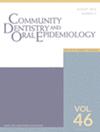Effects of dental insurance and dental care utilization on oral health-related daily life activities among federally qualified healthcare center patients in the United States
Abstract
Objectives
To assess the association between dental insurance, dental care utilization and oral health-related impact on daily activities among patients visiting Health Resources and Services Administration (HRSA)-funded health centers in the United States.
Methods
This cross-sectional study examined the 2014 Health Center Patient Survey (HCPS), a survey of patients who received care at US health centers. Logistic regression analyses were conducted to explore the likelihood of the oral health-related impact on daily activities domains such as school/work performance, sleeping, eating/chewing, social and home activities considering sociodemographic, dental insurance, and dental care utilization.
Results
Among 7002 total participants, 6890 self-reported oral health-related impact on daily activities. Adults aged 18–44 were 2.6 times more likely to report an overall impact on everyday life activities compared to children and adolescents. After adjusting for sociodemographics, Hispanic patients were less likely to report any oral health-related impacts, while patients visiting rural centres reported higher odds of oral health related impairment. Patients who experienced delays in receiving dental care or were unable to access dental care when needed were 4.5 times more likely to encounter difficulties in their daily activities.
Conclusions
This study linked limited dental insurance and care to increased oral health issues impacting daily life, particularly among adults, rural populations, and those facing delay in dental care. This highlights the need for policy reforms and interventions aimed at improving dental care access to mitigate the detrimental effects of poor oral health on daily functions for vulnerable populations.

 求助内容:
求助内容: 应助结果提醒方式:
应助结果提醒方式:


